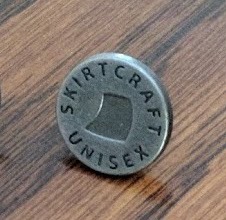Why does a unisex skirt have to look masculine?
A skirt does not have to be masculine-looking to be unisex. Any skirt can be considered unisex.
In 2013, I started a sewing project that would eventually become Skirtcraft. I’d realized that, recent Western convention notwithstanding, there wasn’t a reason for me (a man) not to wear skirts. They were among the oldest and simplest of garments. People, regardless of gender and throughout the world, had worn skirt-like clothes for most of human history. Why let an arbitrary, contemporary, local custom restrict my wardrobe?
The sort of skirt that appealed to me personally was one that:
- was constructed of relatively heavy fabric
- had large pockets
- had a unique style
I couldn’t find many options that matched my criteria, so I started designing and sewing. That project became the Unaligned Skirt.

The design could have been marketed as menswear, since the person whose taste guided the design was a man. Instead, it was, and is, marketed as unisex—because:
- Designating it as “men’s” for marketing purposes would be as arbitrary and unnecessary as the societal designation that restricts skirts to women.
- Womenswear has a severe lack of functional pockets, and people are pissed.
- Though no clothing product fits all body types, some garment designs fit women on average better than men, or vice versa. For a skirt, the body proportion that has some correlation with physical sex and is a design consideration is waist/hip ratio.
- The Unaligned Skirt, though, is an A-line skirt; it sits at the waist and then flares out fairly quickly from there. So it’s relatively accomodating of different dimensions.
- It doesn’t fit everyone perfectly. If your waist/hip ratio is a bit lower or higher, it may be tight or loose in the hips. Due to factory minimums, it only comes in eight waist sizes and one length, so it may not fit your waist, or may fall too high or too low on your knees. But these sorts of limits are there for any garment, whether unisex or not, due to the diversity of people’s bodies.

So—the three distinguishing features of Skirtcraft skirts became:
- large pockets, belt loops, and heavier fabric (functional style)
- unique designs (aesthetic style)
- unisex marketing
Beyond the skirts being dubbed unisex, I use the phrase “Unisex Skirts” heavily: it’s in the headline of the website and was the title of the Kickstarter campaign when it was live. I like to draw attention to the concept of skirts being worn regardless of sex because I think that skirts are so conceptually walled off as womenswear (literally symbolizing women: 🚺) that many men will unconsciously filter something out as soon as they encounter the word “skirt”. That’s a problem, since I want to encourage people to have open minds (and maybe sell them things 😉). So I often put the word “unisex” front and center.

To summarize:
- It's not the case that Skirtcraft’s aim is to make unisex skirts, and that I’ve concluded that for a skirt to be unisex, it must have a style similar to our skirts.
- The aim of my designs (whether or not one reads them as masculine) is to fill a functional and aesthetic gap in the set of skirts that are available. I market them as unisex because there’s no reason to do otherwise, and I prominently feature the word “unisex” in order to jog people’s assumptions.
